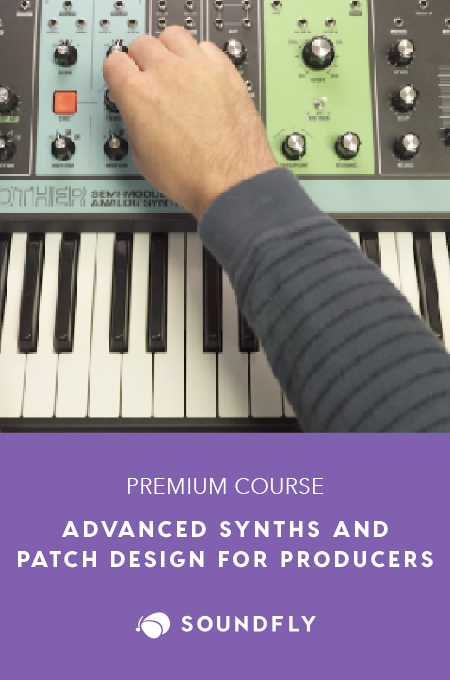
+ Learn the nuances of producing beats, arranging tracks, and creative sampling, drawing on the rich history and influence of hip-hop in Soundfly’s acclaimed online course, The Art of Hip-Hop Production.
Just like Kanye West, Kendrick Lamar is a rapper whose succession of albums shows off a clear yet non-obvious arc of creative development — moving from a space of “talented yet safe” to “risky, daring, and innovative.”
West went from doing the best possible version of what people were already doing, on College Dropout in 2004, to doing the best possible version of what people could never have imagined on The Life of Pablo in 2016. Lamar’s 2010 album, Section.80, is basically his own “College Dropout moment,” since it was really meant to begin gathering and prepping an audience for the truly groundbreaking material to come: 2015’s To Pimp a Butterfly, obviously, and 2017’s DAMN.
With the arrival of the recent Black Panther: The Album, listeners get to see the newest step in this process. An album “inspired by the movie,” as opposed to a straightforward soundtrack, this album represents Lamar taking another step towards dominating more and more of not just the music industry, but the entire media industry (what studio wouldn’t let him to direct a movie, with the help of a couple high-powered execs behind him?).
It’s becoming clearer and clearer now, that Lamar has been doing much more than “just” rapping on his projects all along, despite the official album credits telling a different story. His name might be hidden behind the moniker “The Little Homies” on music video credits, but it’s obvious now that Lamar plays an extremely important role when it comes to the production of his songs’ beats, too.
Take this for example:
On Black Panther: The Album, the song, “X” utilizes the same original lyrical sample in a multitude of compositional ways — within the lyrics, tucked into the beat, and as a structural musical device. The lyric, “Are you on 10 yet” is used in the foreground during the chorus at 0:15; it’s used like a new instrumental element in the beat, at 2:58; it’s even used as a rhythmic loop rotator to re-start a new 4-bar grouping during 2Chainz’s verse, at 3:08.
Could the credited producers here — Sounwave and Illmind — possibly have come up with all that on their own? Yes. But did Lamar have something like that in mind for the production when he wrote such a dynamic, flexible rhythmic line? Also, yes.
On Lamar’s five previous albums, he garnered a grand total of exactly one published producer credit (for “Untitled 04 | 8.14.2014.”), from the 2016 compilation EP, untitled unmastered. We can ignore for a second, the fact that Lamar probably doesn’t need to pad out his credits for the sake of earning more royalty dollars, however, this public credit conundrum does run contrary to the stories from producers who have worked closely with Lamar.
Legendary producer 9th Wonder might have taken the original samples and made the three beats for “DUCKWORTH.” (from DAMN.), but according to him, it was Lamar who actually chose to put all three beats together. In an interview with NPR, another star producer, Mike Will Made It, said that Lamar took Mike Will’s original beat for the song “DNA.” and just kept rapping even after it had faded out. This forced the producer to make a completely new beat for the second half.
Despite the fact that Lamar so greatly influenced the outcome of both of those songs’ musical arrangements, he isn’t credited as a producer on either of them.
But on this new Black Panther: The Album project, Lamar is now garnering a total of five official production credits (on the songs: “Black Panther,” “I Am,” “Bloody Waters,” “Redemption Interlude,” and “Seasons”). In advertisements for this soundtrack, Lamar is most often referred to as a “curator,” as someone who would simply be choosing the best music that was made by other people.
Unfortunately, Lamar’s admirable modesty might here be obscuring the real story. With each new album, his foreground rapping and his backing accompaniments have become too blurred and intertwined for him to have not at least been in the room, throwing out ideas, when the producer sat down to make the final mix.
This new release is just more proof of that. Lamar’s official production credits probably lag behind his real tally by at least a few tracks, if not dozens. His rapping is just too inextricably bound to how the accompaniment behind him progresses forward. In fact, it’s almost like he remixes his own material before it even comes out.
A great example of this close structural interaction comes from that same Mike Will “DNA.” beat. Lamar opens the song with the line, “I got loyalty, got royalty, inside my DNA.” Later on, he quotes these lines again in the left channel, while in the right channel, he now simultaneously adds a completely new idea, “I live a better life / I’m rollin’ several dice / F**k your life / I live a bett– / F**k your life.”
And as if this cacophony isn’t already enough to overload your listening capacity, he overlays in the center channel, Geraldo Rivera opinionated spiel:
“This is why I say that hip-hop has done more damage to young African Americans than racism in recent years.”
Behind all this chaos, Al Shepard’s actual countdown from his 1961 space flight ticks off the seconds until the next beat blasts off at 2:06. And are you ready for the real kicker?
When the song starts, its BPM is around 140. By the time the “I got loyalty” sample comes back in here to help make the transition between these beats, it has slowed to about 135 BPM. Finally when the new beat arrives, it lands at 130 BPM. He uses the aeronautic countdown to literally count down his BPM numbers…

Why does this matter? Could Mike Will have set all that up? Yes. But typically when stuff like that gets done in tandem with raps, you have to know where you were going from the moment you put pen to paper, and then put samples to drum machines.
On Black Panther, Lamar takes all this intertwining of beat and rap to the next level. On the opening song, “Black Panther,” every instance of the word “king” in Lamar’s rap is reflected somewhere in the backing beat. It shows up to the left, the right, high, low, whispered, shouted — it’s no coincidence that we find the same intricately braided production here, as “Black Panther” is one of the few songs on which Lamar is actually credited as a producer.
So when this song ends with a dramatic build-up that repeats the same “king” lyric eleven straight times, reinforcing the established, while turning it into something completely new, we really can’t pretend like we’re surprised anymore.
Kendrick Lamar isn’t just a great rapper; he’s a great producer. It’s just that he’s taken the opposite career path of Dr. Dre, and Kanye West after him. Lamar started filling headphones with his exciting lyrics and delivery, and only then did he start to supply the exciting beats. The only question now is which domain of art he’ll decide to conquer next.
Sculpture, anyone?

Continue learning about mixing, beat making, vocal recording, and DIY audio production, with Soundfly’s in-depth online courses, including Faders Up: Modern Mix Techniques, Pop Vocal Production, and The Art of Hip-Hop Production. Subscribe for unlimited access here.




